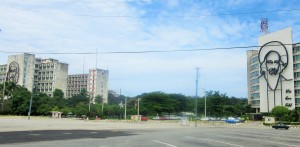Cuba’s National Hero: Camilo Cienfuegos

October 28th, 2015 marks 56th anniversary of the death of Camilo Cienfuegos (1932-1959), one of the five heroes of the Cuban Revolution (1953–1959) along with Fidel and Raúl Castro, Ché Guevara, and Juan Almeida Bosque (1927-2009).
Cienfuegos played a major role in overthrowing the corrupt and dictatorial regime of Fulgencio Batista (1901-1973), which oppressed the Cuban people and committed countless crimes. During Batista’s rule, American companies were essentially permitted to control the Cuban economy and run it according to their own interests, while the U.S. Mafia and businessmen participated in organized crime. This situation came to an end with the victory of the Cuban revolution, when Cienfuegos and the four other heroes sought to establish an independent Cuba that prioritized the interests of its own citizens.
Cienfuegos obtained a very prominent position in the revolutionary movement almost immediately after his first meeting with Fidel Castro in 1955. That meeting transpired in Mexico, where 82 revolutionaries that were exiled from Cuba organized the movement to overthrow Batista’s oppressive regime. In November 1956, all 82 of these revolutionaries embarked on a 10-day journey to return from Mexico to Cuba on the now-famous yacht called Granma, which actually had the capacity to transport only 12 people. Once in Cuba, the revolutionaries decided to advance to the Sierra Maestra mountain range in order to meet up with other supporters of the revolutionary movement against Batista’s dictatorship. However, only 12 of them managed to survive the journey and reach Sierra Maestra, as they came under multiple attacks by the Cuban Army.
Shortly thereafter, in 1957, Cienfuegos was appointed to the highest rank of Commanding Officer and chief of the army, which exceeded the ranks of both Raúl Castro (Commander of the Rebellious Army in Oriente) and Ché Guevara (Commander of the Rebellious Army in Cabaña). Then, on December 31, 1958, Cienfuegos played a key role in the victory in the Battle of Santa Clara, as he and Guevara led the two columns that captured the city. This essentially marked the victory of the revolutionary movement as, just one day later on January 1, 1959, Batista fled the island and his corrupt and oppressive U.S.-backed government was replaced with a revolutionary socialist state.
In addition to marking the end of American imperialism in Cuba, the victory on January 1, 1959 also concluded 467 years of serfdom and exploitation by a foreign power. Spain dominated and exploited Cuban labour and resources from 1510 until its defeat in the Spanish-American War of 1898. Unfortunately, the victory over Spain did not bring Cubans the liberation and independence that they had hoped for. Instead, one oppressor was merely substituted for another.
After its victory in the Spanish-American War, the U.S. transformed Cuba into a neo-colony. Subsequently, in the years following 1898, the U.S intervened militarily and exercised imperial power over Cuba, exploiting its natural and human resources, and dictating Cuba’s domestic and foreign policies. During that period, the Cuban economy became highly dependent on the U.S., as “74% of Cuba’s exports were destined for the US, while 73% of its imports came from the US…the all-important Cuban US sugar export market and price were controlled in Washington” (Ritter, 2010, p. 3). In fact, “[b]y the 1950s, the U.S. controlled 80 percent of Cuban utilities, 90 percent of Cuban mines, close to 100 percent of the country’s oil refineries, 90 percent of its cattle ranches, and 40 percent of the sugar industry”[1].
In addition to exploiting Cuba’s natural resources and labour, U.S. dominance also led to the vulnerability of women on the island being taken advantage of as, prior to the revolution, many girls in the urban areas served as prostitutes for American tourists and businessmen. Shortly after the revolution, the Cuban regime shut down all casinos and brothels, marginalized the mafia, and curtailed international tourism to the island. Furthermore, the Cuban government also nationalized foreign enterprises and utilities, and instituted a number of land and agrarian reforms. The U.S. retaliated by imposing a commercial, economic and financial embargo in 1962, which blocked almost all trade between the two countries and banned U.S. citizens from travelling to Cuba.

The anniversary of the death of Camilo Cienfuegos is commemorated every year on October 28th in Cuba. In 2009, on the 50th anniversary of his death, Camilo’s face was added to the Plaza de la Revolución, beside that of Ché Guevara, along with his famous quote: “Vas bien, Fidel ” (You’re doing fine, Fidel). Camilo is also featured on Cuban currency, as he is depicted on the convertible and non-convertible 20 peso bills.
The name of Cienfuegos is always remembered along with those of Antonio Maceo Grajales (1845-1896) and José Julián Martí Pérez (1853-1895), two well-known Cuban independence heroes, as well as Fidel Castro, Raúl Castro, Ché Guevara, and Juan Almeida Bosque, the leaders of the 1959 Cuban Revolution. The names of all of these independence heroes are synonymous with movements against neo-colonial or imperialist domination, economic colonization, exploitation and humiliation. They have served as inspirations for similar movements since the victory of the Cuban Revolution and will continue to do so well into the future. As Fidel Castro stated in his speech to announce the death of Camilo Cienfuegos to the Cuban people on November 1, 1959: “There are many Camilos among our people!”
Notes
[1] https://revcom.us/a/056/cubahist-en.html


